| Welcome |
|
October 9, 2019
Canes?
Hi ,
A couple times last week the subject of using a cane came up with patients. There is a time and place for 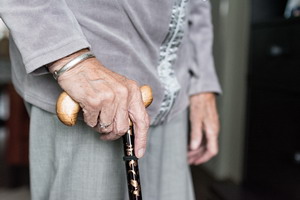 canes, but most of the time I see them being used inappropriately. So I thought I would share my thoughts on canes and similar walking assistance devices. canes, but most of the time I see them being used inappropriately. So I thought I would share my thoughts on canes and similar walking assistance devices.
The idea behind using a walking assistive device is to make walking movements easier and less painful. Sometimes a patient may have an unstable knee or hip joint that they just don't trust to hold them up consistently. Other times that knee or hip may be too painful to put full weight on it. But the most common reason I find people reaching for canes, walkers, and rollers is because of a loss of their balance
capabilities.
The idea of a cane is to provide a third leg for greater  balance. By adding the pressure input from the hand on the cane, your balance centers in the brain get a lot more information to work with than they do just from what the feet are telling them. It is this extra information about where your body is in space that a
compromised brain needs to figure out how to stay upright and balanced. One of the neurological tests I do is to simply watch a person stand while their eyes are closed. If that person sways at all, I then know that the balance centers of their brain are not working up to par. Most of the time the person has no idea that they are swaying. I then have them try to stand on one foot with their eyes closed. A healthy person should be able to do this for 15 seconds
without a lot of arm swinging or leg kicking. How well do you do? balance. By adding the pressure input from the hand on the cane, your balance centers in the brain get a lot more information to work with than they do just from what the feet are telling them. It is this extra information about where your body is in space that a
compromised brain needs to figure out how to stay upright and balanced. One of the neurological tests I do is to simply watch a person stand while their eyes are closed. If that person sways at all, I then know that the balance centers of their brain are not working up to par. Most of the time the person has no idea that they are swaying. I then have them try to stand on one foot with their eyes closed. A healthy person should be able to do this for 15 seconds
without a lot of arm swinging or leg kicking. How well do you do?
If these tests fail, I might test further with some standard techniques such as the old eyes closed and touch your nose, the touch the index fingers together out in front of yourself - again with eyes closed, and possibly walking heel to toe with eyes open. These are all tests for  awareness of where you are in space. When
you open your eyes you are using a completely different set of brain pathways for balance. Unfortunately the visual system is not fast enough to prevent you from falling if your foot slips or twists on something in your path. You need the tiny proprioceptive (balance) nerves around your knees and ankles working to prevent falls. Fortunately these can be retrained fairly easily and quickly simply by practicing balancing on one foot with your eyes closed several times a day.
Grab a wall or counter to steady yourself and catch yourself while you try to balance by intermittently letting go for progressively longer amounts of time. awareness of where you are in space. When
you open your eyes you are using a completely different set of brain pathways for balance. Unfortunately the visual system is not fast enough to prevent you from falling if your foot slips or twists on something in your path. You need the tiny proprioceptive (balance) nerves around your knees and ankles working to prevent falls. Fortunately these can be retrained fairly easily and quickly simply by practicing balancing on one foot with your eyes closed several times a day.
Grab a wall or counter to steady yourself and catch yourself while you try to balance by intermittently letting go for progressively longer amounts of time.
Clearly I prefer rebuilding healthy functional balance over compensating by using a cane for balance. I have a larger issue with canes however. When you look at a person using a cane you see someone bent forward  looking at the ground. This is terrible for your back. Most people using a cane for balance want to create
a tripod effect for greater stability. Consequently they use the cane way out in front of themselves. The incorrect pattern is placing the rubberized end of the cane out a foot or two in front of themselves and then a shuffle step motion up to the cane, then repeat. This works for balance, but at the expense of your back. looking at the ground. This is terrible for your back. Most people using a cane for balance want to create
a tripod effect for greater stability. Consequently they use the cane way out in front of themselves. The incorrect pattern is placing the rubberized end of the cane out a foot or two in front of themselves and then a shuffle step motion up to the cane, then repeat. This works for balance, but at the expense of your back.
So what do I recommend for the short run until you rebuild your natural balance or in the long run if your balance centers are permanently damaged as they are in the case of the stroke Ellen had in her brain stem? I recommend using a walking staff. A staff should be about the height of your shoulder or a bit more. You do not lean over the staff but rather grip the staff and pull yourself up. You get the same tripod effect for stability and walk up to it in the same way with the added advantage of standing upright with your eyes looking forward at where you are going. If you need the staff to do some actual support of weight, you will want a good stout solid staff. If you only need the staff as a stabilization aid, then a light weight walking pole will work fine.
You get the same tripod effect for stability and walk up to it in the same way with the added advantage of standing upright with your eyes looking forward at where you are going. If you need the staff to do some actual support of weight, you will want a good stout solid staff. If you only need the staff as a stabilization aid, then a light weight walking pole will work fine.
So what is the proper use for a cane? When you have a painful knee or hip from which you want to take some of the weight off, then a cane is ideal. Here the cane is used as a way to use the strength of the arm to function as a partial replacement for the leg. When you have to take a lot of weight of the leg, as you walk the rubberized end of the cane is always placed beside the outside ankle of the sore leg and
moved with the compromised foot as it steps forward for short time use. For longer use when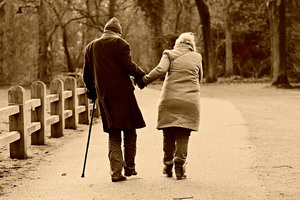 the leg can support you somewhat, reverse the position of the cane to the good leg side to coordinate the natural movement of the opposite arm and leg so the cane moves forward at the same time as the bad leg to take some of the weight from the opposite side. This is fairly old school these days
as your doctor usually gives you orthopedic foot, knee, or hip braces to do this job. These are much easier to use as your arms are left free to do their normal jobs. If complete weight needs to be lifted from one leg, crutches are routinely used. the leg can support you somewhat, reverse the position of the cane to the good leg side to coordinate the natural movement of the opposite arm and leg so the cane moves forward at the same time as the bad leg to take some of the weight from the opposite side. This is fairly old school these days
as your doctor usually gives you orthopedic foot, knee, or hip braces to do this job. These are much easier to use as your arms are left free to do their normal jobs. If complete weight needs to be lifted from one leg, crutches are routinely used.
Sometimes a person’s balance is compromised to so such a degree that a simple tripod is not enough to provide the level of stability needed. Assuming there is still leg strength and hip mobility, such that an actual 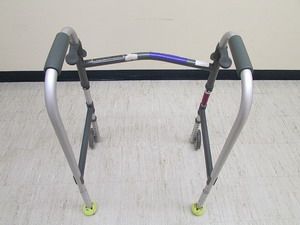 wheelchair is not the only option, then a walker my be in order. Typically these come with wheels on
the front two legs and a slide on the back two legs. These are nice because they still keep the person upright like the staff does. The length of the legs need to be adjusted so that the person is not leaning forward on the walker. You want any weight support to come from the arms pushing straight in line with the body, not rolling along out in front of the person. Step forward into the space of the walker and into a full upright position with each step. wheelchair is not the only option, then a walker my be in order. Typically these come with wheels on
the front two legs and a slide on the back two legs. These are nice because they still keep the person upright like the staff does. The length of the legs need to be adjusted so that the person is not leaning forward on the walker. You want any weight support to come from the arms pushing straight in line with the body, not rolling along out in front of the person. Step forward into the space of the walker and into a full upright position with each step.
A newer contraption is the Rollator. As people get older they lose muscle mass due to not enough exercise and poorer digestion of proteins. This is not a necessary outcome of aging as you can use improved protein quality and quantity to compensate for the poorer digestion combined with digestive aids like hydrochloric acid and protein enzymes taken with meals containing protein. The exercises needed to maintain
muscle strength is not that great when you use super slow weight lifting and brief (20 to 30 second) bursts of aerobic movement periodically throughout the day. But the reality is most people do not take the responsibility to care for themselves. Consequently they get weaker as they age. Yes, there is the slow down of growth hormone as we age that is an issue for muscle growth, but this can be compensated for by doing brief 60 hour fasts or fast mimicking diets periodically to
boost up growth hormone levels.
Most people don't do these things, so they get weak to the point that it becomes too much effort for their legs to do all the work of walking. Enter the Rollator, the four 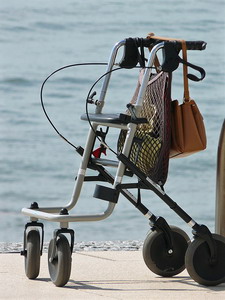 wheeled walker to add stability and allow you to use arm strength to help support your weight. They even provide a convenient seat to sit down on to
rest whenever you get tired. They are useful for these people, however I have one main complaint. The brakes on these things should work in an opposite manner to how they are designed. Currently the brakes work just like bicycle brakes. This is crazy. If a person starts to slip or fall, they are not going to think to put on the brakes. Plus there is no way to hold the brakes locked while you want to turn around to sit down. So your chair could easily
roll right out from under you. The brakes should be always on and only released by the person squeezing them while they are walking. wheeled walker to add stability and allow you to use arm strength to help support your weight. They even provide a convenient seat to sit down on to
rest whenever you get tired. They are useful for these people, however I have one main complaint. The brakes on these things should work in an opposite manner to how they are designed. Currently the brakes work just like bicycle brakes. This is crazy. If a person starts to slip or fall, they are not going to think to put on the brakes. Plus there is no way to hold the brakes locked while you want to turn around to sit down. So your chair could easily
roll right out from under you. The brakes should be always on and only released by the person squeezing them while they are walking.
A last device to mention is the Hemi cane. Ellen and I have found that there is a real absence of supportive 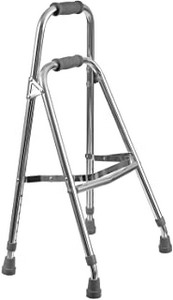 devices for people with one sided dysfunction, such as after a stroke. Everything is built for people with two good arms. The one helpful device for stroke patients is the Hemi cane. It provides a sturdy
free standing support for the good arm of the stroke patient. They are light weight and have four feet for providing good upward support for the weight of the stroke patient. They suffer some of the drawbacks of any cane, so the height needs to be adjusted carefully. devices for people with one sided dysfunction, such as after a stroke. Everything is built for people with two good arms. The one helpful device for stroke patients is the Hemi cane. It provides a sturdy
free standing support for the good arm of the stroke patient. They are light weight and have four feet for providing good upward support for the weight of the stroke patient. They suffer some of the drawbacks of any cane, so the height needs to be adjusted carefully.
This newsletter may seem rather specialized, but when patients start asking questions in the office, I know it is time to do a newsletter on the subject.
Take care,
David
Ellen update: 
The office wanted to go out to lunch for my birthday as we do for each office staff's birthdays. We ended up going to El Tapatio on Sunrise. Of course what birthday would be complete with the required humiliation of wearing an over-sized sombrero while waiters sing Happy Birthday ole!
|
| |
| |
| |
Less than 6 hours sleep increases death risk  New research is showing that getting a good 8 hours of sleep each night is actually protective against the damages caused by such chronic diseases as heart disease and diabetes. People who only get 6 or less hours a night have double the risk of dying from stroke or heart disease and triple the risk of dying from cancer.
New research is showing that getting a good 8 hours of sleep each night is actually protective against the damages caused by such chronic diseases as heart disease and diabetes. People who only get 6 or less hours a night have double the risk of dying from stroke or heart disease and triple the risk of dying from cancer.
Sleep
_____________________________________________
"It is difficult to free fools from the chains they revere."
~ Voltaire
__________________________________
Many raw veggies are bad for you UCSF and Harvard have been studying the effects of raw food versus cooked food on the microbiome in your gut. Little difference show up between eating cooked versus raw meat, but significant differences are present between cooked versus raw veggies. The biggest problems showed up with starchy foods like sweet potatoes, which damaged the microbiome when eaten in raw form.
UCSF and Harvard have been studying the effects of raw food versus cooked food on the microbiome in your gut. Little difference show up between eating cooked versus raw meat, but significant differences are present between cooked versus raw veggies. The biggest problems showed up with starchy foods like sweet potatoes, which damaged the microbiome when eaten in raw form.
Raw vs. cooked
________________________
"Life is thickly sown with thorns, and I know no other remedy than to pass quickly through them. The longer we dwell on our misfortunes, the greater is their power to harm us."
~ Voltaire
_________________________________________________
Moderate consumption of red meat not a health problem The nutrition community has been arguing this one for a long time - is eating red meat bad for you? Most studies have only been association studies comparing populations that eat red meat and those that don't. This is very poor quality research. This latest announcement is the result of doing five separate metastudies looking at large numbers of previous studies of all sorts, and the results reviewed by
14 experts. The final conclusion - there is no evidence to show eating moderate levels of red meat is harmful to health.
The nutrition community has been arguing this one for a long time - is eating red meat bad for you? Most studies have only been association studies comparing populations that eat red meat and those that don't. This is very poor quality research. This latest announcement is the result of doing five separate metastudies looking at large numbers of previous studies of all sorts, and the results reviewed by
14 experts. The final conclusion - there is no evidence to show eating moderate levels of red meat is harmful to health.
Red Meat
_________________________________________
"Optimism is the madness of insisting that all is well when we are miserable."
~ Voltaire
_____________________________
Our address is 9725 Fair Oaks Blvd. suite A
Our hours are M - F 10 to 3:30
Finding the new location is very easy. Coming from highway 50 up Sunrise Blvd, you turn left and go up a block. We are on the right hand side - the building just past the Subway Sandwich shop. If you are coming down Sunrise from the Mall area then just turn right on Fair Oaks Blvd and up a block on the right.
If you are coming from the Roseville area you could come down Sunrise Blvd, but that is a long trek. It is probably shorter time wise to come down Auburn Blvd - San Juan Ave like you have been for the Sunset office, but instead of turning left at Sunset, keep going straight 3 more lights to Fair Oaks Blvd and turn left. Go down 2 lights to New York Ave, go through the intersection, and immediately turn into the turn lane once the center
divider ends. We are on the left.
You are free to reprint this article in your newsletter as long as you include the following statement in the same size type and color:
"This article appears courtesy of Fair Oaks Health News, offering natural and healthy solutions for body, mind and soul. For a complimentary subscription,
visit http://www.fairoakshealth.com"
Referral doctor for when we are out of town: Jennifer Webb DC
Jennifer Webb DC
6216 Main St. suite C1
Orangevale
988-3441
|
| |
|
|
|
_______________
to check on old newsletters
_______________
About Dr. DeLapp
|
Dr. DeLapp has been a philosopher, non-force Chiropractor, medical intuitive, and health innovator for over 35 years. He began experimenting with medical intuition in 1972 while studying physics at UC Davis. In addition to physics he designed and completed an individual major in the philosophy and psychology of education. Shortly after he choose to pursue a career in the only
truly health oriented profession available at that time, Chiropractic. He graduated with honors in 1981 with his doctorate and opened a private practice.
Since that time he has continued his research into the effects of consciousness and learning on health.
He developed the Biomagnetic Retraining system for correcting movement abnormalities.
Since 1991 he has focused on developing a powerful system for uncovering and assisting the mind-body connection in health and personal growth. The in-depth coaching, guided by the subconscious direction from the body, is called Heartflow. It is available at Fair Oaks Health.
Fair Oaks Healing
& Arts Center
Staff
 Dr David DeLapp DC
Dr David DeLapp DC
Chiropractor
Ellen Flowers FGM
Spiritual Life CoachEnergetic Nutritionist
Health Care Coordinator
Susan Richardson
Office Manager
Front Desk
Sherry Herrera
Front Desk Person
Susan McDonald
Catherine Cummings
Purity Oil Spray
Pain Relief
Essentials
CBDs plus 9 essential oils

Ear Drops

Eye Drops

Super Concentrated
Fish oil

Gut Healer

Sinus Rinse
Powder

Balanced Salt
|
|

